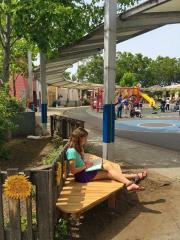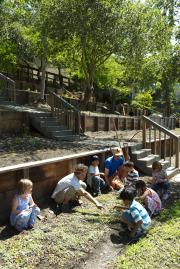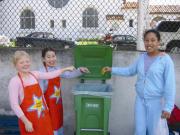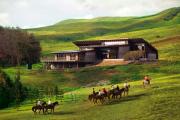How Green is Boulder’s Valley?
What does it look like when an entire school district turns green? To find out, I visited the Boulder, Colorado schools on a crisp winter day in February 2012 and discovered a district in the process of a remarkable transformation of its entire system of education and operations, in collaboration with the city and many non-profit partners. From my meetings with everyone, from the Superintendent, Board members and the district Sustainability Coordinator to the students, teachers and staff in the schools, it was vividly clear that Boulder is a shining example of how schools can embrace the highest standards of environmental sustainability.
For over two decades, The Boulder Valley School District (BVSD) has been developing a commitment to environmental stewardship, especially through recycling and alternative transportation programs. Recently the district has committed to “embracing environmental sustainability at a new level” for its 27,000 students, 4,000 staff, and 57 schools in three counties. In 2006 Boulder passed a $300 million bond for school improvement, and the change process took off. As a first step, the district hired Ghita Carroll, a Ph.D. scientist, to serve as BVSD’s first sustainability coordinator. Having earned her undergraduate degree in environmental science and social studies from the University of Wisconsin, she served as the energy program manager for the University of Colorado, where she recently received her doctorate in environmental science with a special focus on renewable energy. Under her leadership, the Board adopted a new Sustainability Vision Statement, declaring Boulder’s commitment “to becoming a leader in environmental sustainability by creating healthy learning environments, while providing students with the skills to address the systemic challenges faced by the world in this new century.”
The Board then unveiled a new sustainability policy that defines Boulder’s vision “to educate students about lifestyles and technologies that limit our negative impact on the environment and use natural resources in a manner that maintains quality of life and reduces consumption to a sustainable level.” The Board noted that “in order to lead by example and to be good stewards of the public's trust, the District will establish and operate healthful, safe and productive learning environments while practicing environmental and fiscal responsibility.” Importantly, the Board also directed the Superintendent to create a Sustainability Management System (SMS) that will “define a vision, goals and strategies for achieving district-wide environmental sustainability, and will serve as a roadmap for integrating these concepts into our curriculum and operations” and will enable BVSD “to monitor, evaluate and report on the District’s progress toward environmental sustainability.”
In the fall of 2009 Boulder launched its new Sustainability Management System (SMS) developed by a task force and stakeholders to establish baselines, define sustainability, and create plans to integrate sustainability into operations and curriculum. The SMS established a baseline inventory of energy and water consumption, solid waste generation and diversion rate, fuel consumption by the transportation fleet and associated greenhouse gas emissions for the entire district.
The impact of BVSD’s new commitment to sustainablity has been demonstrable. Among the accomplishments, BVSD has a power purchase agreement to provide 14 Boulder schools renewable energy with photovoltaics, a wind turbine was installed at a middle/high school that will power lights and support the science curriculum, February has become a "green month" when high schools compete to reduce energy consumption, and empowered students have held a S.U.P.E.R. Summit (Students Understanding Personal Environmental Responsibility). The district is focusing on green operations that feature the use of green cleaning products in all schools, paperless newsletters, and the adoption of Integrated Pest Management practices.
In the course of my whirlwind day in Boulder, I observed the district-inspired changes firsthand when I visited four schools—New Vista High School, Arapahoe Campus High SchoolCasey Middle School, and Columbine Elementary School—and two partnership organizations, Eco-Cycle recycling and Thorne Nature Experience.
At New Vista, a small public school of choice founded in 1993 and enrolling 320 students, principal Kirk Quitter greeted us and proudly described the efforts made to retrofit the original 1953 building. He introduced us to the student members of Earth Task Force, who are leading the effort at greening the school. As one senior told us, she grew up in a “wildernessy family” and was attracted to the school’s environmental and outdoor programs. The students showed us the fruits of their labors--low energy vending machines with healthy food options, low flow toilets installed with a grant of $2000 from the Alliance for Climate Education (ACE), composting, recycling, a student-run garden and farm to table lunch program.
At nearby Arapahoe Campus High School, we saw a small career-training program focused on environmental education taught by educator Heather Riffle. With students she operates an extensive greenhouse and introduces them to career options in sustainability including alternative energy programs, urban agriculture and natural resource management. In partnership with the local community college, her program gives students a head start on higher education. At Arapahoe’s cafeteria, we met with Ann Cooper, who heads Lunch Lessons, a district-wide food program that offers students local, organic, seasonal food at a reasonable price. The self-described “renegade lunch lady” and fervent advocate of radically transforming our nation’s school nutrition programs, Cooper herself manages a staff of 200 who provide 6 million meals a year to Boulder students. The pasta and salad lunch she served us was delicious!
At Columbine Elementary School we learned about Boulder’s ambitious plan to revitalize the district’s school buildings through the 2006 Bond. After extensive analysis at Columbine, the district decided to raze a decrepit, inefficient 1954 building and then construct a new, 68,000 square foot building designed to LEED standards for a cost of $13,435 (including the demolition and all soft costs) or $198 a square foot. With a district operating budget of $270 million, reducing the annual $6.5 million energy bill is a top priority.
The crown jewel of the BVSD is the new, LEED platinum Casey Middle School, only one of two public middle schools in the nation to receive that designation. Artfully using portions of the original 1924 building, the architects incorporated many sustainable features including an extensive geothermal heating and cooling system, day lighting, and water efficiency features and a bioswale to reduce runoff. The RB+B architectural team giving us the tour observed that designing the building gave them the opportunity to embrace strategies to produce zero net energy buildings in the future. At Casey the faculty have fashioned the curriculum to help students become ecologically aware citizens, as part of the recently drafted Colorado Environmental Literacy Plan. Using the LEED certified building itself, sixth grade students gather and analyze live data from the site as part of an 8-week unit on energy. Seventh graders study how a building impacts its ecosystem by creating an in-class simulation of a pond’s loss of habitat. And in eighth grade, students study climate change and calculate the carbon footprint of the building.
The Boulder Valley School District has developed a strong partnership with the Eco-Cycle program dating back to 1987. Begun with four schools in 2005, the new Green Star Schools program now includes 31 schools with 15,000 students and staff, and another 18 schools are signed up to participate. The program goals are to reduce waste, increase recycling, implement compostable green waste, and improve environmental awareness and participation. The Green Star Schools now divert 2/3 of their waste from the landfill, and in so doing are saving the district significant dollars. Our field trip to the Eco-Cycle’s single-stream center dramatically demonstrated why reducing waste is a first priority; with a vast array of conveyor belts circulating the materials, a small army of workers toiled in very tough conditions to sort the recyclables. The message: it’s good to recycle, even better to reduce consumption!
The district has created another partnership with Thorne Nature Experience (TNE), which operates a nature-study program on land reclaimed from a former city dump. TNE aims to “build Earth stewardship by connecting youth to nature through joyful, hands=on, place-based environmental and educational experiences.” All district fourth graders participate in an environmental program at TNE, learning about wildlife, exploring the marsh, and good environmental practices. Hundreds of thousands of Boulder students have participated in school-sponsored or summer program nature experiences at TNE since it was founded sixty years ago.
The vision of environmental sustainability declared by the Boulder Valley School District is indeed inspiring. The district is carefully integrating a commitment to efficient facilities, healthy operations, an ecological curriculum, nutritious food, and student engagement. These are the elements that define a green school. In Boulder they are applying these principles on large scale, achieving systemic environmental improvements, and helping to keep their beautiful valley green.







